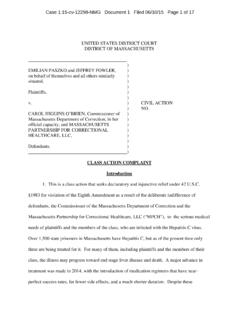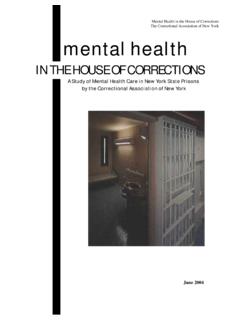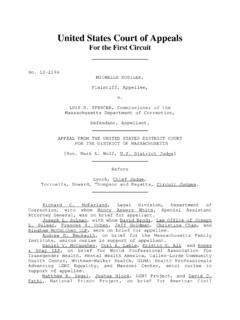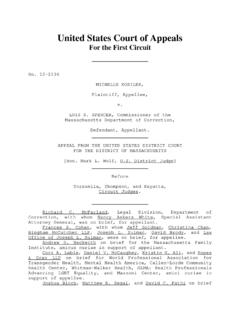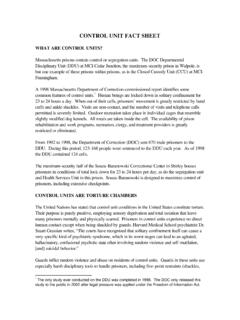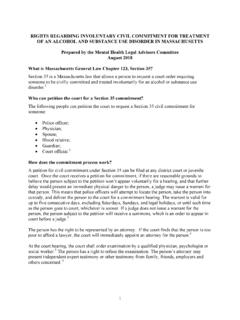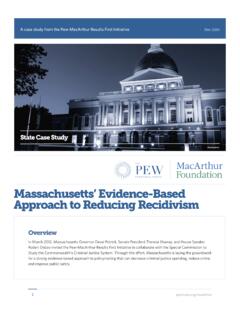Transcription of The Prison Journal
1 Prison Journal DOI: 2007; 87; 254 The Prison JournalMarlene Samuelson, James Carmody, Jon Kabat-Zinn and Michael A. Bratt Correctional FacilitiesMindfulness-Based Stress Reduction in The online version of this article can be found at: Published by: On behalf of: Pennsylvania Prison Society can be found at:The Prison Journal Additional services and information for Email Alerts: Subscriptions: : : #BIBLSAGE Journals Online and HighWire Press platforms): (this article cites 30 articles hosted on the Citations distribution. 2007 SAGE Publications. All rights reserved. Not for commercial use or unauthorized by guest on July 19, 2007 from 254 Mindfulness-Based StressReduction in MassachusettsCorrectional FacilitiesMarlene SamuelsonCurry College, Milton, MAJames CarmodyJon Kabat-ZinnMichael A. BrattUniversity of massachusetts Medical School, WorchesterMindfulness-based stress-reduction courses were offered in drug units in sixMassachusetts department of Corrections prisons.
2 A total of 1,350 inmatescompleted the 113 courses. Evaluation assessments were held before andafter each course, and highly significant pre- to post-course improvementswere found on widely accepted self-report measures of hostility, self-esteem,and mood disturbance. Improvements for women were greater than those formen, and improvements were also greater for men in a minimum-security,pre-release facility than for those in four medium-security facilities. Theresults encourage further study and wider use of mindfulness-based stressreduction in correctional :mindfulness-based stress reduction; meditation; stress reduction;substance abuseIndividual criminal behavior has been attributed to an inadequate abilityto effectively deal with severe stress, deprivation, and low self-esteem,and with peer pressure and the codes of behavior of groups such as factors can be severely compounded by the injection or ingestion ofdrugs and alcohol, which offer the user relief from emotional discomfort byimpairing or eliminating normal levels of awareness and impulse Prison Journal Volume 87 Number 2 June 2007 254-268 2007 Sage Note:The authors would like to acknowledge Yunsheng, MA, PhD Anne Skillings,MS Timothy Light, Tamara Parvizi, MA Joseph Kappel, Diana Kamila, MA and Joanna Bratt,JD, for their involvement in analyzing or working with the data and Saki Santorelli, EdD, forcommenting on the article.
3 Distribution. 2007 SAGE Publications. All rights reserved. Not for commercial use or unauthorized by guest on July 19, 2007 from Under such circumstances, intense feelings such as fear, frustration, anger,and greed can rapidly result in antisocial behaviors, and the resultant incar-ceration in correctional institutions brings additional stress, with the possi-bility of further exacerbating these conditions (Fogel, 1993; Perkins, 1998).The regular practice of meditation has been shown to help individuals cul-tivate deep and long-lasting experiences of inner calm, well-being, self-worth, and self-respect (Kabat-Zinn, 1993). For this reason, there has beenincreasing interest in recent years in the efficacy of meditation-based inter-ventions in correctional institutions as a means of helping inmates deal withthe stress of incarceration and to acquire life-long inner resources to decreasethe likelihood of continuing criminal behavior and recidivism.
4 The rationaleis that through the regular practice of meditation, inmates can grow to be lessreactive to intense emotional states without resorting to the use of drugs orother chemical substances (Kabat-Zinn, 1993). There are reports of Prison -based studies of Vipassana meditation (Anonymous, 2000; Marlatt et al.,2004; Parks et al., 2003), transcendental meditation (TM; Alexander et al.,2003; Hawkins et al., 2003; Orme-Johnson & Moore, 2003; Shanmugam,1992), and mindfulness meditation (Murphy, 1995; Perkins, 1998). The pre-sent study is based on a program of mindfulness is a sustained nonreactive attention to one s ongoing mentalcontents and processes (physical sensations, perceptions, affective states,thoughts, and imagery) (Grossman, Niemann, Schmidt, & Walach, 2004;Kabat-Zinn, 2005; Miller, Fletcher, & Kabat-Zinn, 1995).
5 Mindfulness istraditionally cultivated through formal training in mindfulness meditation,and the resultant stable, nonreactive awareness appears to act as a resourcefor more creative responding by bringing mental processes into greater con-scious awareness and under greater voluntary control (Shapiro & Walsh,2002). Moreover, because this natural capacity is under the individual sdirect control, it can provide an experience of mastery (self-efficacy), sothat thoughts and intense feelings no longer threaten to overwhelm(Teasdale, 1999; Teasdale et al., 2000). For many inmates, this may be theirfirst experience of inner control of mind or body stress reduction (MBSR) is an 8-week program ofintensive training in mindfulness (moment-to-moment awareness) and itsintegration into everyday life.
6 MBSR was developed at the University ofMassachusetts (UMass) Medical Center in 1979 by Dr. Jon Kabat-Zinn(1990) to provide a coping resource for patients dealing with intensephysical symptoms, chronic medical conditions, and difficult emotionalsituations (Kabat-Zinn, 1994). Since that time, more than 16,000 peoplewith a wide range of disorders and difficult life situations have completedSamuelson et al. / Mindfulness-Based Stress Reduction255 distribution. 2007 SAGE Publications. All rights reserved. Not for commercial use or unauthorized by guest on July 19, 2007 from 256 The Prison Journalthe ongoing program at UMass, and programs based on Kabat-Zinn smodel are now widely available throughout the United States and in othercountries. The MBSR program has also been used in stressful inner-citycommunity settings (Roth & Creaser, 1997; Roth & Stanley, 2002) and ina therapeutic community for substance abuse treatment (Marcus et al.)
7 ,2003). Reports have demonstrated a high level of adherence or compliancewith the behavioral demands of MBSR (Kabat-Zinn & Chapman-Waldrop,1988; Speca, Carlson, Goodey, & Angen, 2000; Williams, Kolar, Reger, &Pearson, 2001), with about 85% of enrollees completing the program. Anumber of studies have demonstrated positive attitudinal, health, andbehavioral changes associated with MBSR (Kabat-Zinn, 1982; Kabat-Zinn,Lipworth, & Burney, 1985; Miller et al., 1995). These changes includeimprovements in psychological and physical well-being and reductions inanxiety and depression (Kabat-Zinn, 1992; Kaplan, Goldenberg, & Galvin-Nadeau, 1993; Teasdale et al., 2000). The changes have been found toendure at 3-month follow-up (Williams et al., 2001), 6-month follow-up(Carlson, Ursuliak, Goodey, Angen, & Speca, 2001) and 4-year follow-up(Kabat-Zinn, Lipworth, Burney, & Sellers, 1987).
8 The MBSR program hasalso been adapted and integrated into a variety of other clinical andnonclinical settings (Kristeller & Hallett, 1999; Linehan, 1993; Saxe et al.,2001; Teasdale et al., 2000).Based on the belief that some of the psychological factors that lead tocriminal behavior may be changed through the practice of mindfulness(Kabat-Zinn, 1993), the UMass Stress Reduction Clinic and the MassachusettsCouncil on Criminal Justice agreed to conduct a program of MBSR in pris-ons in the massachusetts department of Corrections system. The MBSR program was one of several options offered in a rehabilitation program forinmates incarcerated as a result of drug-related convictions. The programwas not designed or conducted as a formal research study, and limitationsimposed by administrative constraints, and the need to adapt to differencesamong the various Prison settings, necessitated some modifications fromthe way in which MBSR programs are usually conducted at UMass (Kabat-Zinn, 1990) and foundations and methodology of MBSR have been described in detailelsewhere (Kabat-Zinn, 1990; Santorelli, 1999).
9 Briefly, in the more usual distribution. 2007 SAGE Publications. All rights reserved. Not for commercial use or unauthorized by guest on July 19, 2007 from clinical setting, approximately 20 participants attend 8 weekly, and an all-day, mostly silent retreat or intensive experience during thesixth week. During these sessions, participants receive training in mindful-ness through a body scan meditation, sitting meditation, and mindful stretch-ing exercises. There is a good deal of group discussion on the integration ofmindfulness into everyday life and the application of mindfulness as amethod for noticing habitual reactions to stressful situations and more cre-atively responding (Kabat-Zinn, 1990). Some didactic material on the psy-chology and physiology of stress reactivity is also presented.
10 Participants areexpected to engage in formal mindfulness meditation practice for 45 minutesper day outside of class, guided by audiotapes or CDs that are Institution Settings, Environment, and ProgramApproximately 2,000 inmates participated in the MBSR program in sixcorrectional institutions in massachusetts between 1992 and 1996. Theprograms were offered in the massachusetts women s Prison at Framinghamand in five correctional institutions for men the four medium-security facil-ities at Shirley, Gardner, Norfolk, and Old Colony and at the minimum-security, pre-release facility at Shirley. The MBSR program was offered asone of a variety of options, in 6- to 8-week blocks, to inmates in drug unitswithin these institutions. The other options included smoking cessation, liter-acy training, and exercise and walking programs.
